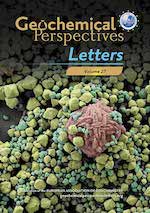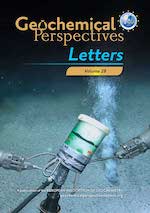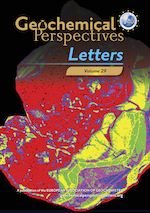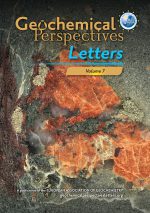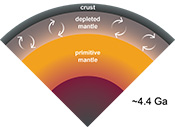 | Hadean geodynamics inferred from time-varying 142Nd/144Nd in the early Earth rock record Abstract: Tracking the secular evolution of 142Nd/144Nd anomalies is important towards understanding the crust-mantle dynamics in the early Earth. Excessive scatter in the published data, however, precludes identifying the fine structure of 142Nd/144Nd evolution as the expected variability is on the order of few parts per million. We report ultra-high precision 142Nd/144Nd data for Eoarchean and Palaeoarchean rocks from the Isua Supracrustal Belt (SW Greenland) that show a well-resolved 142Nd/144Nd temporal variability suggesting progressive convective homogenisation of the Hadean Isua depleted mantle. This temporally decreasing 142Nd/144Nd signal provides a direct measure of early mantle dynamics, defining a stirring timescale of <250 Myr consistent with vigorous convective stirring in the early mantle. The 142Nd/144Nd evolution suggests protracted crustal residence times of ~1000-2000 Myr, inconsistent with modern-style plate tectonics in the Archean. In contrast, a stagnant-lid regime punctuated by episodes of mantle overturns accounts for the long life-time estimated here for the Hadean proto-crust. |
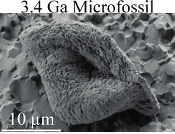 | Chemical nature of the 3.4 Ga Strelley Pool microfossils Abstract: The biogenicity of putative traces of life found in early-Archean rocks is strongly debated. To date, only equivocal lines of evidence have been reported, which has prevented a full consensus from emerging. Here we report elemental and molecular data from individual organic microfossils preserved within the 3.4 billion-year-old cherts of the Strelley Pool Formation, Western Australia. The present results support the growing body of evidence advocating their biogenicity, promoting them as the oldest known authentic organic microfossils. These microfossils consist of nitrogen- and oxygen- rich organic molecules that have been only slightly degraded despite experiencing temperatures of ~300 °C. Such molecular preservation emphasises the palaeobiological potential of the Earth’s oldest geological record, whilst providing a promising window into the early biosphere. |
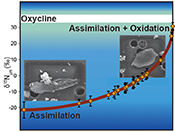 | Nitrogen isotope signatures of microfossils suggest aerobic metabolism 3.0 Gyr ago Abstract: There is compelling evidence for early oxygenation of mid-Archean oceans. However, the biological use of molecular oxygen is still not ascertained. Here we report the nitrogen isotope composition measured in isolated microfossils (δ15Nµm) from the 3.0 billion years old Farrel Quartzite metasediments. We show that the quasi-null bulk δ15N values of Farrel Quartzite organic matter encompass a large 15N isotopic heterogeneity at the scale of isolated microfossils (-21.6 ‰ < δ15Nµm < +30.7 ‰). Rayleigh fractionation is required to yield such large δ15N variations. Based on these data, we propose a model in which negative δ15Nµm values determined on film-like and on spheroidal microfossils are explained by ammonia assimilation in the anoxic deeper levels of the water column, whereas positive δ15Nµm values determined on lenticular microfossils were driven by both ammonia assimilation and aerobic oxidation close to the sea surface. Since ammonium aerobic oxidation requires the presence of free molecular O2 within the water column, we further suggest that positive δ15Nµm values reflect an ocean redox stratification tightly related to O2 production by oxygenic photosynthesisers in a mid-Archean ocean 3.0 Gyr ago. |
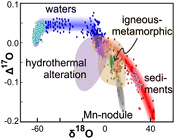 | Mass-dependent triple oxygen isotope variations in terrestrial materials Abstract: High precision triple oxygen isotope analyses of terrestrial materials show distinct fields and trends in Δ′17O - δ′18O space that can be explained by well understood fractionation processes. The Δ′17O - δ′18O field for meteoric waters has almost no overlap with that of rocks. Globally, meteoric water defines a λ value of ~0.528, although a better fit to waters with δ18O values >-20 ‰ is δ′17O = 0.52654 (±0.00036) δ′18O + 0.014 (±0.003). Low temperature marine sediments define a unique and narrow band in Δ′17O - δ′18O space with high δ′18O and low Δ′17O values explained by equilibrium fractionation. Hydrothermal alteration shifts the rock composition to lower δ′18O values at low fluid/rock ratios, and finally higher Δ′17O when F/R ratios are greater than 1. In order to make the triple isotope data tractable to the entire geological community, consensus on a reporting scheme for Δ′17O is desirable. Adoption of λRL= 0.528 (λRL = slope of δ′17O - δ′18O reference line, the ‘Terrestrial Fractionation Line’ or TFL) would bring the ‘rock’ community in line with well established hydrological reporting conventions. |
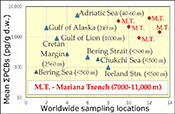 | Toxic anthropogenic pollutants reach the deepest ocean on Earth Abstract: Persistent organic pollutants (PCBs and PBDEs) were analysed in sediment core samples (0-2 cm) from the southern Mariana Trench at water depths of 7000-11000 m. ∑PCBs concentrations ranged from 931 to 4195 pg/g, far higher than those recorded before in marine sediments from shallower depths. Toxic Equivalence (TEQ) of dl-PCBs ranged from 0.650 – 14.9 pg/g, which is higher than most marine surficial sediments at <500-2500 m ocean depth, recovered from semi-industrial to industrial areas. However, ∑8PBDEs values (averaging ~136 pg/g) were lower than those in surficial sediments from shelf areas recorded in past studies. Evidently, anthropogenic pollutants have reached the deepest realm on Earth, and the Mariana Trench acts as a repository for POPs amplification. The high concentration of PCBs is an eye-opener, which is directly affecting our deep sea ecosystems, considering their pervasiveness and persistence in trench sediments. |
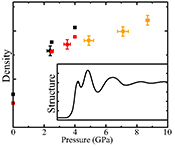 | Properties of molten CaCO3 at high pressure Abstract: We report here the structure of molten CaCO3 studied by in situ X-ray diffraction using a Paris-Edinburgh press up to 8.7 GPa. Variations are observed in the medium range order with shrinkage of the intermolecular contributions, reflecting higher packing efficiency of the carbonate molecules. Density of the melt is obtained from the radial distribution functions, assuming a constant coordination number of 3 for the C-O contribution. Bulk modulus values increase by a factor of 2 over the experimental pressure-temperature range, reaching a value similar to that of underlying crystalline phases at the highest pressure investigated. These are the first direct density measurements of compressed CaCO3 melt; they agree well with recent ab initio predictions (Li et al., 2017), which implies that the reported flattening of the melting curve followed by a slightly negative curve above 8 GPa cannot be due to crystal-melt density inversion. Instead, the enthalpy of fusion is likely responsible, and we note the peculiar high diffusivity of oxygen in crystalline calcite-V in this regard, with further implications for the mobility of carbonate melts at depth. |
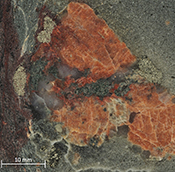 | Geochemistry and metallogeny of Neoproterozoic pyrite in oxic and anoxic sediments Abstract: The Neoproterozoic Dalradian Supergroup contains widespread diagenetic sulphides present as pyrite. The sulphides occur in both carbonaceous shales and glacial diamictites, that were deposited in relatively reducing and oxidising conditions respectively. The trace element compositions of the pyrite, and consequently the whole rock compositions, contrast between the two lithologies. The highest concentrations of selenium, tellurium and gold are all found in diamictite-hosted pyrite. The data suggest that increased mobility of these elements in oxidising conditions led to greater uptake when pyrite was precipitated. As one model for the formation of orogenic gold ore deposits assumes a sulphide-rich protolith, pyrite ultimately formed during relatively oxidising conditions could make a contribution, including the widespread pyrite precipitated during the Neoproterozoic ‘Snowball Earth’ glaciations. |
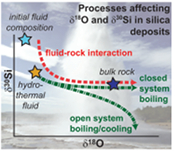 | Silicon and oxygen isotopes unravel quartz formation processes in the Icelandic crust Abstract: Quartz formation processes in the Icelandic crust were assessed using coupled δ18O and δ30Si systematics of silica deposits formed over a wide temperature range (<150 to >550 °C). Magmatic quartz reveals δ18O (-5.6 to +6.6 ‰) and δ30Si (-0.4 ± 0.2 ‰) values representative of mantle- and crustally-derived melts in Iceland. Hydrothermal quartz and silica polymorphs display a larger range of δ18O (-9.3 to +30.1 ‰) and δ30Si (-4.6 to +0.7 ‰) values. Isotope modelling reveals that such large variations are consistent with variable water sources and equilibrium isotope fractionation between fluids and quartz associated with secondary processes occurring in the crust, including fluid-rock interaction, boiling and cooling. In context of published δ18O and δ30Si data on hydrothermal silica deposits, we demonstrate that large ranges in δ30Si values coupled to insignificant δ18O variations may result from silica precipitation in a hydrothermal fluid conduit associated with near-surface cooling. While equilibrium isotope fractionation between fluids and quartz seems to prevail at high temperatures, kinetic fractionation likely influences isotope systematics at low temperatures. |
| Reply to Comment on “Ultra-high pressure and ultra-reduced minerals in ophiolites may form by lightning strikes” by Griffin et al., 2018: No evidence for transition zone metamorphism in the Luobusa ophiolite Reply to Comment on “Ultra-high pressure and ultra-reduced minerals in ophiolites may form by lightning strikes” by Griffin et al., 2018: No evidence for transition zone metamorphism in the Luobusa ophiolite Griffin et al. (2018) discard our lightning experiments because we did not identify ultra-high pressure (UHP) phases. Our experiments (Ballhaus et al., 2017) provide the first rational explanation of many unusual findings in the so-called UHP ophiolites and hence undermine the foundations on which the resulting speculative geotectonic scenarios are based. Little room seems left to postulate that ultramafic rocks along the Jarlung-Zangbo suture zone have seen Transition Zone (TZ) pressures (McGowan et al., 2015; Griffin et al., 2016a); that chromite crystallised as high pressure polymorph in the calcium ferrite (CF) structure (Xiong et al., 2015); or that the upper mantle is super-reduced (Griffin et al., 2016b). | |
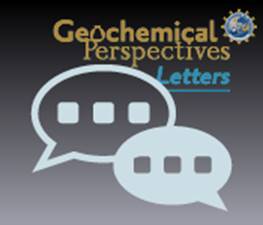 | Comment on “Ultra-high pressure and ultra-reduced minerals in ophiolites may form by lightning strikes” Comment on “Ultra-high pressure and ultra-reduced minerals in ophiolites may form by lightning strikes” Ballhaus et al. (2017) use electric-discharge experiments to argue that lightning strikes could produce ultra-high pressure (UHP) and super-reduced (SuR) phases “identical to those found in ‘high-pressure’ ophiolites” and that thus there is “not sufficient evidence to challenge long-established models of ophiolite genesis”, specifically for the UHP processing of Tibetan ophiolites. However, the authors produced no evidence for UHP phases in their experiments. There are pertinent observations, relevant to the authors’ assertions, in the literature regarding the relationship between the UHP and SuR assemblages in the Tibetan peridotites. Their conclusions are not consistent with this evidence. |
<< Previous issueNext issue >>


